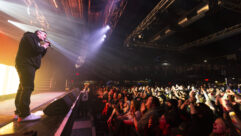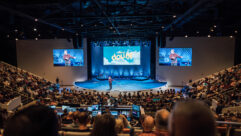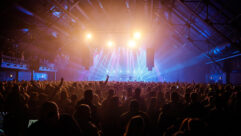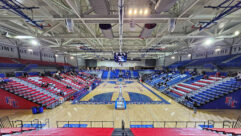On the SVC Podcast, Contributing Editor Bennett Liles talks with Doug Hood of Custom Sound Designs regarding their complete re-design and installation of a versatile Danley speaker-based sound system for the First Missionary Church in Berne, Indiana. While trying to keep its more traditional members, the church wanted to explore ways to interest new, younger generation members for contemporary services. Custom Sound Designs provided a versatile sound system that can accommodate both.
Links of Interest:
· Custom Sound Designs in Ft. Wayne, Indiana
· Danley SH-95 3-way 11-driver horn used for left and right main house
· Danley SH-60 horn loudspeaker used for main house center
This is the SVC Podcast from Sound & Video Contractor Magazine with Doug Hood of Custom Sound Designs. Show notes and product links for this podcast and others are at svconline.com. Just go to Podcasts at the top of the page.
First Missionary Church in Berne, Indiana wanted to keep its traditional members while reaching out to a younger congregation on events with more sights and sounds. They called in Custom Sound Designs of Fort Wayne and CSD’s Doug Hood is going to tell us how they set it up for a pushbutton change in the whole look and sound. Coming right up on the SVC Podcast.
Doug, thanks for taking a time out to be with us for the SVC Podcast from Custom Sound Designs in Fort Wayne, Indiana. It’s good to have you with us.
Thank you. Yeah, good to be here.
Church AV installations aren’t always that exciting but when you have a situation like the First Missionary Church was facing, it’s all too common today for a church to be figuring a way to appeal to different age groups in their congregation without alienating either one. They called Custom Sound Designs for the job so tell us a bit about Custom Sound Designs.
Yeah. Well, we are – this year we will be 29 years old, so we started back in ’89. So we’ve been around for a little while and worked with a few churches over the years. So we love what we do. We create immersive environments. And where we really excel is when we’re able to take a room like this one that we’re talking about here and we’re able to really transform it. And that means looking at the entire space as a whole environment so we look at sound, we look at acoustics, we look at lighting both for stage and house lighting. And then we also look at video, whether that’s projection, cameras, LED walls, digital signage, all of that. So we really try to look at the entire space as a canvas and then when we’re able to really go in there and look at the whole space in total, then we can do some fun things like we did on this project. [Timestamp: 2:15]
So they came to you for a new AV setup with sound, lighting and video. Did they have some degree of a conflict going on between the traditional and the younger members of the congregation?
I wouldn’t say really a conflict, but they were definitely wanting to get their message out in a way that they couldn’t with their old system. So specifically in music, the old system was just really limiting what they can do; how they can reproduce music, how well they could communicate, how clearly they could communicate. Could they do it? Yes. But could they do it with excellence? No. So that was really the thing that made them reach out to us like a lot of churches. They were making this transition from what had historically been kind of a traditional worship experience to contemporary and they had already kind of started along that process, but the room and the technology didn’t allow them to express that. It was really limiting how effective they could be. I think an AV system either helps you or hurts you. There’s really nothing in between. So it’s either taking your message and really throwing it out there in a way that’s great or it’s taking your message and it’s kind of squashing it and it’s hurting what you’re trying to get out there to your people. So I think their old systems just wouldn’t let them operate to their potential and that goes for more than just sound. If we looked at the visual side of it, it was pretty plain. They couldn’t do anything with color. The screens were pretty small. They weren’t the easiest to read. The lighting was really limited. And so kind of all that stuff was working together – or not working together, depending on how you look at it – to lead up to this decision of saying hey, we need to refresh here. We need to do an upgrade on everything. [Timestamp: 4:07]
For the new sound system you put in Danley speakers and I think you and the church have more than a fair amount of experience with those.
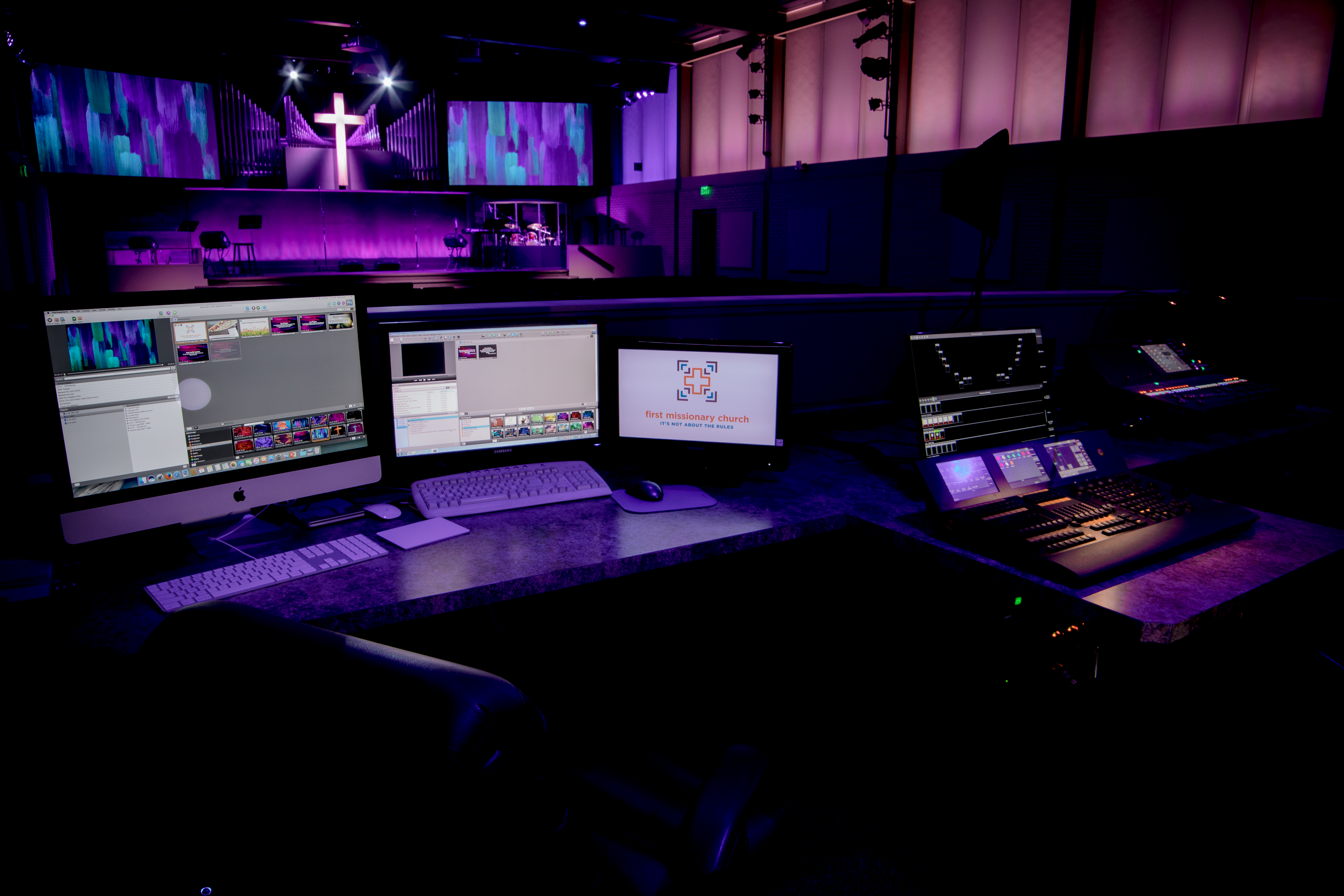
Yeah, we’re a Danley dealer. The church also had a history with Danley. And we had done – shortly before this all went down, we had done a Danley educational event at CSD, which the church had come to. And so they got to hear some of the boxes, they got to meet some of the Danley personnel, and they were just really impressed with everything. We looked at probably three or four other options. We looked at some line array solutions, we looked at some other point source solutions, but all things considered and when we looked at the room and we looked at the budget, Danley came out on top. And they provided a couple of things: better coverage for one, and also better sight lines, which was really important, with the balcony. So we were doing this juggle of trying to have a really powerful PA, which by definition usually that means you’ve got a large footprint of some kind whether that’s a point source box or an array for sure. So you’ve got this need for big boxes, but whenever you have a balcony you’ve got people that are sitting up high and they’ve got to have a clear line of sight to the screens. And so when we started to look at some of the array options it just wasn’t working because the arrays were too tall and then they were impeding the sight lines to the screen. So with Danley, with the big point source boxes, we were able to give really big sound, really good coverage left to right, front to back, and we were also able to keep the sight lines totally clear for everybody in the balcony so everybody could see perfectly all the way to the screens. [Timestamp: 5:49]
And First Missionary Church has a long, deep house to fill with the sound system.
Yeah. In this design we had left-center-right speakers up front which covered the main floor. Left and right we had the SH-96’s and in the center we had the SH-60’s, and those took care of all of the floor very well. We also had a DVH-218, which is a dual 18 sub that was flown center in the front of the room. And then for the back we had three smaller speakers in the back for the balcony delays and those were SM-60’s. So just left-center-right and the fronts and left and right in the back. [Timestamp: 6:30]
And that gets the sound all the way from the stage to the far back end. So what do they do for video in there? Do they use the video for just IMAG or for hymn lyrics?
Yep. They do both camera and ProPresenter for graphics and lyrics and sermon notes and videos. The system that we put in there really lets them do pretty much anything so they can route any content that they want to to the screens, but primarily it’s for graphics. Some of the components of the video system, we have left-right laser projectors – those are by Digital Projection, 8,000 lumen laser. And then there are some TV’s in the back for the balcony. There’s some TV’s on the balcony face for the people that are on stage. And then for IMAG world we’ve got one Panasonic manned camera, we’ve got three Vaddio PTZ camera, and we have three Marshall, kind of the mini POV-style HD cameras. So we’ve got seven cameras overall and that all goes through a Blackmagic 2 M/E switcher, and we’ve got some AJ routing in there. Everything is SDI start to finish, so really low latency, great picture. Just a great, great workflow all the way through. [Timestamp: 7:45]
Okay, so they’re not so traditional that they don’t use a lot of video. It looks like you have the place covered fine for video as well as for the sound system.
It’s really covered well. And they had a history of that so they had not done too much with IMAG within the room, but they had done a lot of recording so that was important to them. So to their credit they had a good foundation of that type of experience already, so basically what we did is just try to upgrade that to the current technology so it made everything HD. Everything before was SD and it was pretty old. So we just kind of upgraded everything and then we also let them come into the world of streaming and recording so they can take their service and both stream it live, capture it, share it with the congregation later. So It’s a pretty comprehensive setup overall. [Timestamp: 8:36]
And when you went in there did you have to do any acoustical treatment to the room before you actually installed the sound system?
Yep. That’s one of the most important things to them and to us as we looked at the speaker system. We didn’t just want to put in new speakers without looking at the room itself, so one of the first things we did is our acoustician did a complete study of the room and we showed them kind of here’s what’s going on now, here’s what we recommend, here’s what the changes would be if we do those recommendations. So yeah, we went through a full acoustic study, full acoustic report, and the end result of that was putting in new acoustic treatments to the side walls and the back walls. [Timestamp: 9:18]
I think there’s some language involved sometimes in getting the importance of acoustics translated to those who are not acoustic engineers and only see the price tag.
Yeah, true. And that’s one of the nice things about the reports that we do. It’s able to communicate that because acoustics is this really weird, hard to understand topic. But we’ve got some neat things that we do with our reporting that it’s able to present it in a way that people can understand. They can see the problem areas and they can see where sound is either bouncing around or collecting and we don’t want it there or we don’t want it to be focused there. And we’re able to show them where the problem is and then show them the solution that we recommend, and then show them the difference that will happen if they do what we recommend. So that acoustic report, it’s a really important thing number one, and it’s a really good communication tool number two. [Timestamp: 10:09]
Now do they do a completely different Sunday service for the younger church members than the one they have for the traditional congregation?
I don’t believe so. I think that the blend – I think depending on what’s going on it may lean more one way than the other. But they do a variety of events from a regular church service. They may have a hymn sing or a gospel sing night. They may do something where it’s more choir led or organ led or different types of orchestral instruments compared to more of a band setup that’s keyboard led or guitar led, drums and bass and all that stuff. So I think there’s a good variety of what they’re doing and depending on the service it may lean one of those ways more than the other, I guess.
And they can do lighting changes to set the tone and change the atmosphere as well.
Yeah. Lighting is tremendous and that was a major focus of the project because lighting prior to this was very limited. The house lighting was some older chandeliers that were just white, dimmable lighting. And we replaced all of that with RGBW, which is red, green, blue, white and full color. So instead of just a chandelier, white only light, now through the entire space – and this goes back to what I said early on about us wanting to create immersive environments – we don’t want to do just something cool on the stage. We want to look at that entire space. And so instead of the chandeliers, which is one type of light, those went away and we put in new pendant lights that each light is full color. So of course we can do white, no problem, but we can also do any color that they want and we can do any color throughout the entire space. So when you combine that with the new lights that we did for the stage and you look at the pictures of the project you look at the cove lighting that runs the length of the room, we took LED strip lights and ran the continuous and entire length of the room front to back. So they have this awesome vertical space that we can color that vertical space any color that you want to. So again, the room just functions like this big, blank canvas and we can really do just about anything that you want to visually in there. [Timestamp: 12:29]
Well, it’s great that you got to put a good solid foundation on the sound system and allow them to set up whatever sort of look they want for the occasion. That’s got to be a real advance in letting them carry their message more effectively. Good of you to give us the details on that and next week we’ll talk about exactly what you did and how you got this set up for them. Talking to Doug Hood from Custom Sound Designs on the complete revamp of lighting, video and sound for First Missionary Church. Good to have you Doug.
Yeah, thank you.
Great having Doug Hood with us from Custom Sound Designs. Next week Doug will take us through the AV control points, handling the rigging and setting up the balcony sound coverage at First Missionary Church. Get back with us for all of that on the next SVC Podcast.


